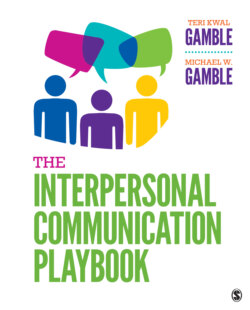Читать книгу The Interpersonal Communication Playbook - Teri Kwal Gamble - Страница 23
На сайте Литреса книга снята с продажи.
Channels
ОглавлениеA message travels via a channel, a medium that connects sender and receiver, much as a bridge connects two locations. We may use multiple channels at the same time to communicate a single message. In fact, under most circumstances, interpersonal communication is a multi-channeled interaction using visual, auditory, tactile, olfactory, and situational means to convey both verbal and nonverbal messages. Consider a first date: You make sure you look and smell nice; you choose a quiet setting to ensure you can hear each other; and you generally put your best face forward in both verbal and nonverbal ways in order to say, “I like you and I hope you like me too.”
Capable communicators are adept channel switchers. They know how to use sound, sight, touch, taste, smell, and the environment, as well as words and nonverbal signs, to get messages across. However, if you find yourself consistently tuning in on just one channel, you might miss the most salient parts of a message. For instance, if you speak to people only by text, you might miss the underlying tone of concern when your best friend asks, “Is everything okay? I haven’t seen you in a while.” While we may prefer to send or receive messages through a particular channel, we should pay attention to and use all of the available channels.
Being adept at channel switching means that if one channel is closed or damaged, we can open another to compensate. For instance, rather than assuming that a blind person will be able to recognize us by our voice, we also should name ourselves. Since the blind person is unable to see the visual cues we use to shade the meaning of a verbal message, we also may need to take special care to ensure that the meanings we want conveyed are contained in the words we choose and the expressiveness of our voice.
